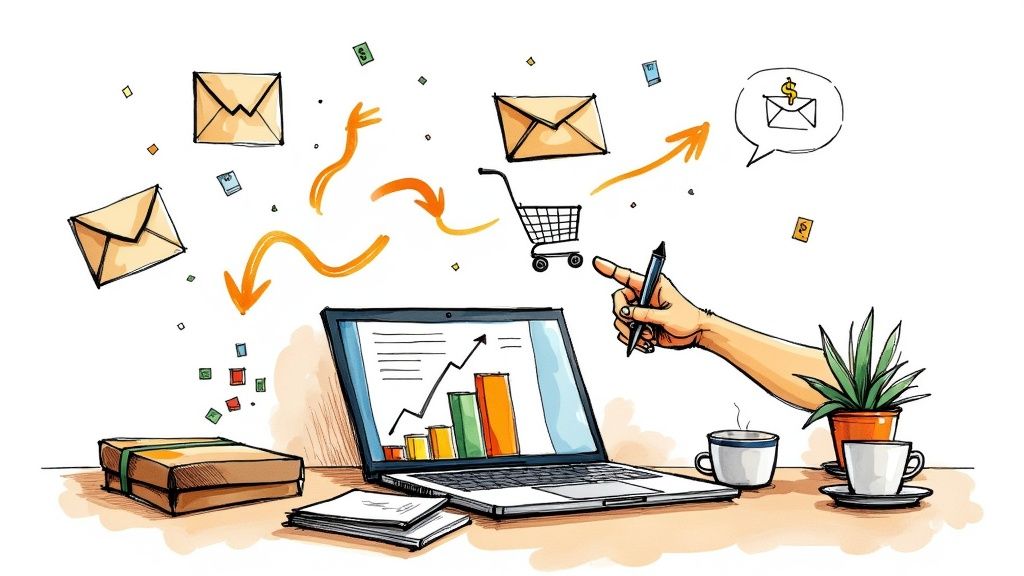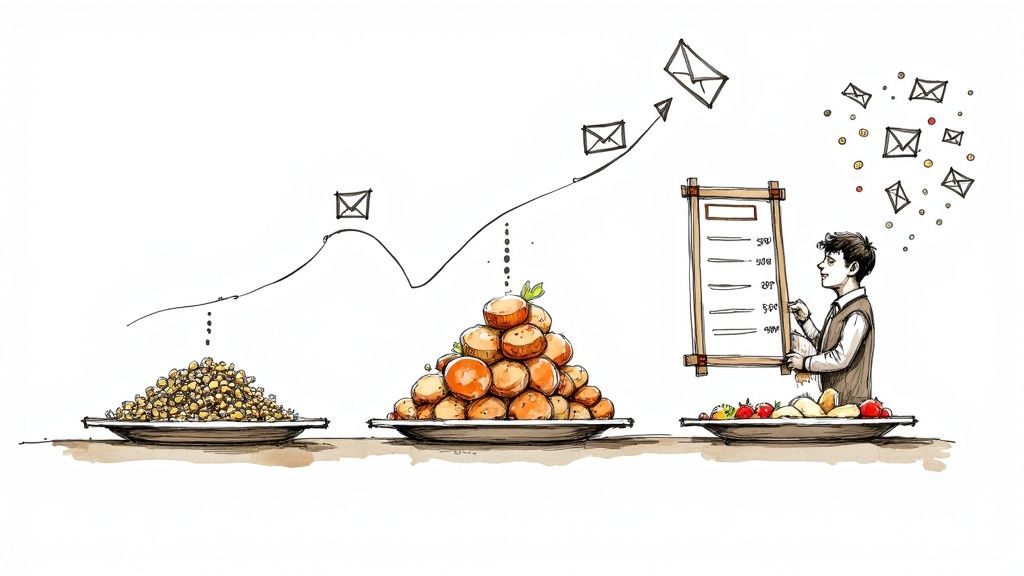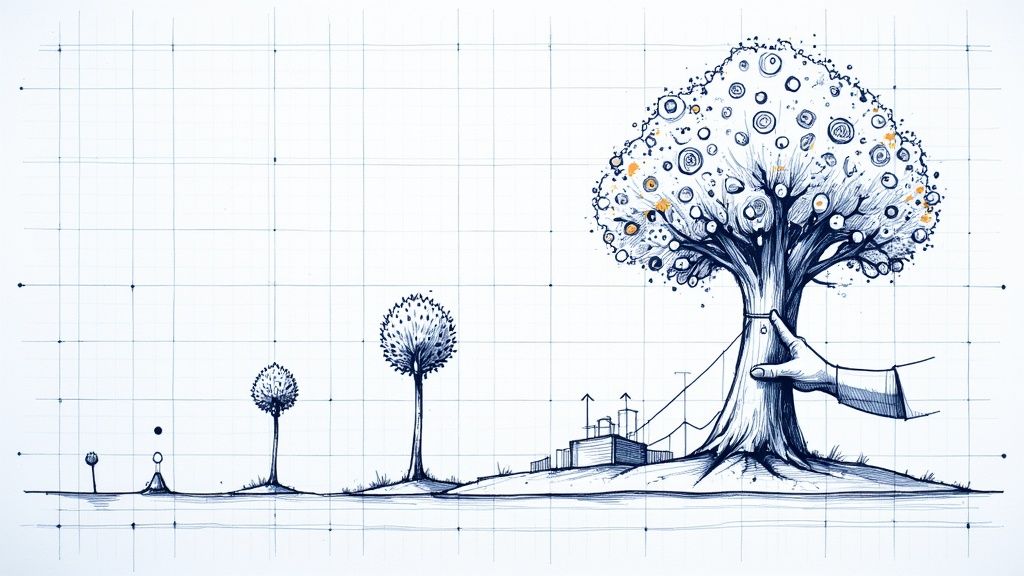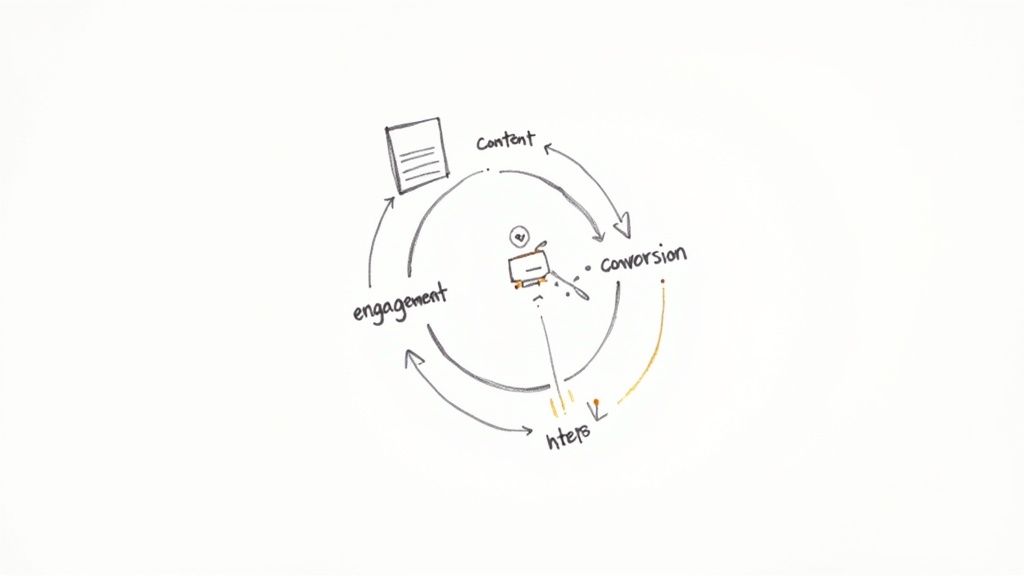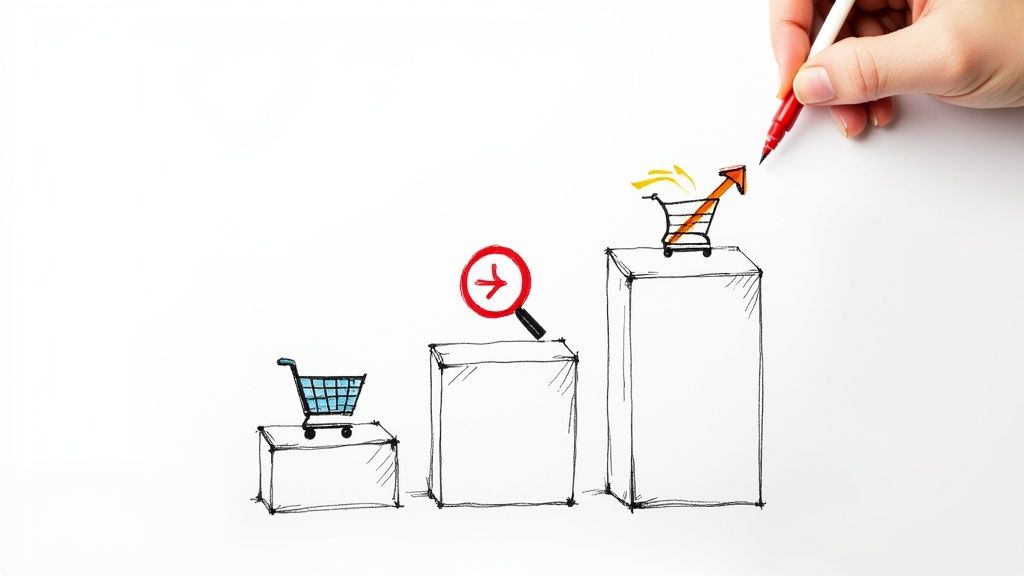Ecommerce Customer Journey: Simple Steps to More Sales
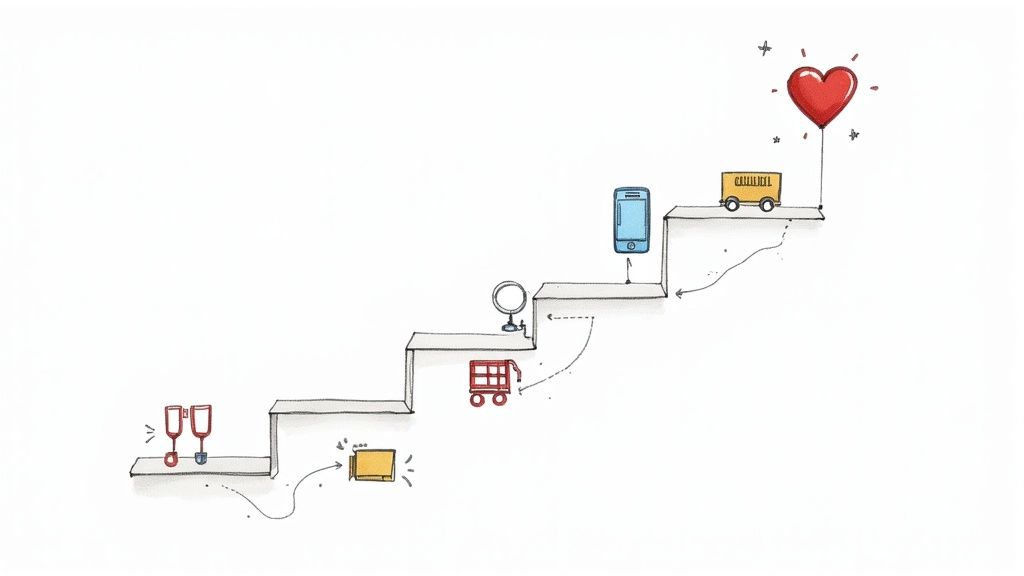
15 mins
6/9/2025
Joe Ervin
- ecommerce customer journey
- customer experience
- conversion rate
- email marketing
- social commerce
Why Every Click Tells a Story
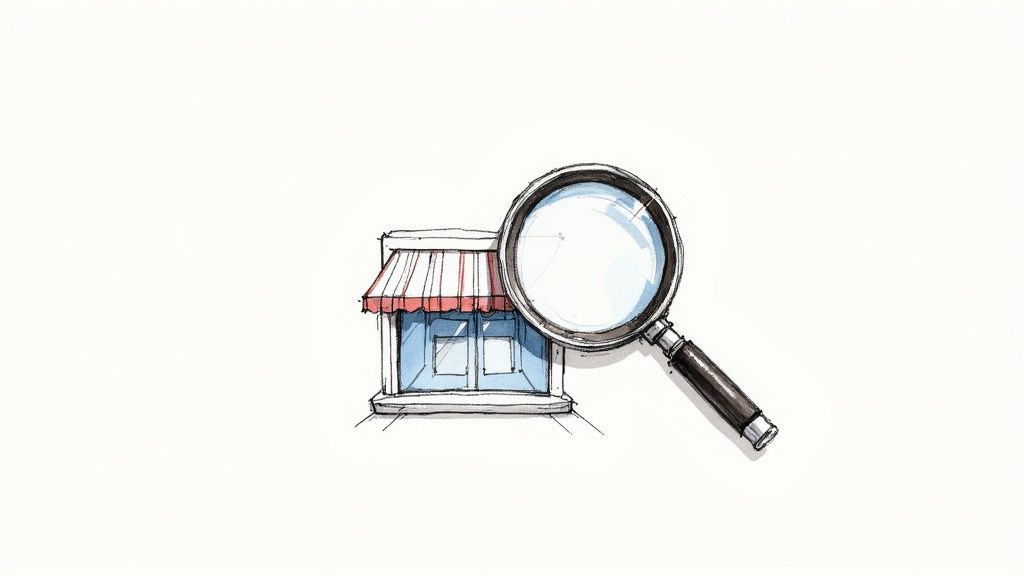
This screenshot shows the many ways businesses visualize the stages of the ecommerce customer journey. Some are simple and straightforward, others more intricate. This highlights the fact that there's no single "right" way to understand how customers interact with your brand.
Instead of magically deciding to buy, your customers follow a path, a winding road with twists and turns. Every click they make, every product page they linger on, every time they return to your site—it all adds up to a story. Think about modern shopping habits: someone might see your ad on Instagram. Weeks later, they're reading reviews. Maybe they even ask for recommendations from friends on Facebook. The decision-making process could take days, even weeks. This isn't random; it's a customer journey, and it’s a goldmine of information.
From Store Visits to Digital Adventures
Shopping itself has undergone a massive transformation. Remember quick trips to the brick-and-mortar store? Now, shopping is a digital adventure. Some people click "buy" within minutes, while others take months to decide. Imagine buying a new phone. You'd probably spend weeks researching different models, comparing specs, and reading countless reviews. But a new phone case? That's a much faster purchase.
This evolving online world means a staggering 2.77 billion people are projected to shop online globally by 2025. That's roughly one-third of the entire planet! Factors like widespread smartphone adoption and easy internet access have fueled this incredible growth. Want to dive deeper into these shifting shopping habits? Check out this insightful article: Digital Commerce Statistics. Customers now interact with brands across multiple platforms before making a purchase—from social media and mobile shopping to even conversing with AI-powered chatbots.
Guiding Customers Along the Path
As a business owner, your mission is to create a frictionless experience. Whether customers are browsing on their phones or desktops, the journey should be smooth and intuitive. Fast shipping and responsive customer service are key. In today's fast-paced world, simplicity and a personal touch are paramount.
Understanding the Ecommerce Customer Journey
The ecommerce customer journey is essentially a roadmap. It charts all the steps a customer takes, from their initial discovery of your brand to making a purchase and, ideally, becoming a loyal advocate. Each interaction along this path is called a touchpoint.
Awareness: Let's say someone needs new running shoes. They stumble upon your ad on Instagram. That's their first touchpoint—the awareness stage. They now know your brand exists.
Consideration: Intrigued, they visit your website and browse through different shoe models. They pore over reviews and compare prices. This is the consideration stage, where they're actively thinking about buying but haven't committed yet.
Decision: After careful deliberation, they finally choose a pair. They add it to their cart. This marks the decision stage—they're ready to buy.
Action: They click that satisfying "Buy Now" button and complete the checkout process. This is the action stage, where the purchase finally takes place.
Loyalty: The shoes arrive, and they love them! They leave a glowing review and rave about them to their friends. They become repeat customers. This is the loyalty stage—they're now a true fan of your brand.
By understanding these stages, you can effectively support your customers at every step. You can showcase the right products, provide valuable information, and streamline the purchase process. This transforms casual visitors into loyal, enthusiastic customers who not only return for more but also become brand ambassadors, spreading the word about your business. This, ultimately, is the power of mapping the ecommerce customer journey.
The Five Steps Every Customer Takes
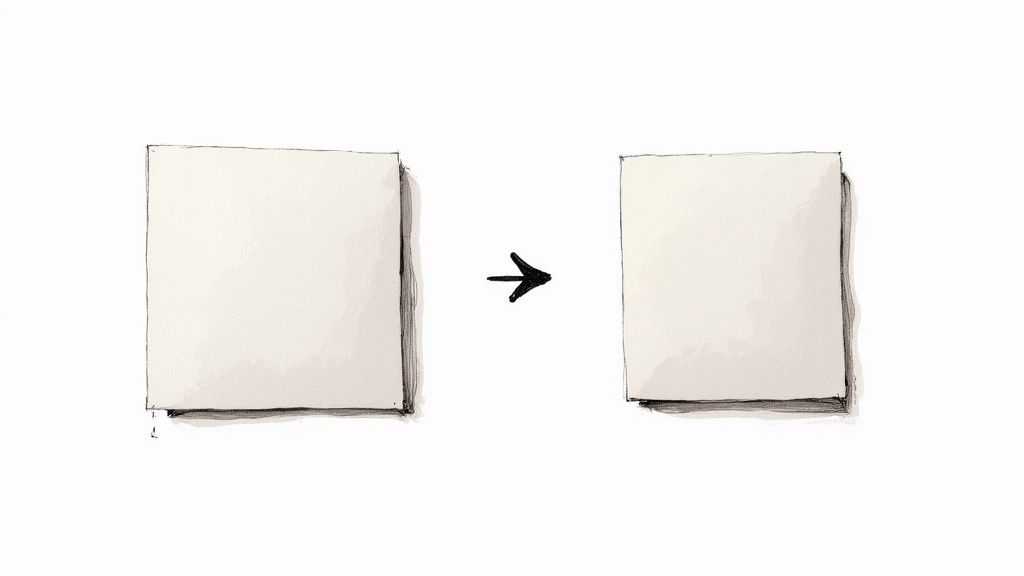
Think of online shopping like climbing a staircase. Each step represents a stage in the ecommerce customer journey. Understanding these stages is crucial for any online business.
Awareness: Realizing the Need
Imagine your coffee maker sputtering its last breath. Suddenly, you're aware of a problem. This is the awareness stage. It's where the customer recognizes a need or desire. This could be triggered by anything from a targeted Instagram ad to a friend's recommendation. Your job at this stage? Get on their radar.
Consideration: Exploring Options
Now you're searching for a replacement coffee maker. You're browsing websites, comparing prices, and reading reviews. You’re in the consideration stage, actively evaluating different solutions. This is where helpful blog posts, detailed product descriptions, and engaging videos can make your brand stand out.
Decision: Choosing a Solution
You've narrowed down your choices. This is the decision stage, often the trickiest part of the journey. The customer is weighing factors like price, features, shipping costs, and return policies. Positive reviews and a strong brand reputation can be the deciding factor.
Action: Making the Purchase
Finally, you click "Buy Now!" This is the action stage, the culmination of the customer journey. A smooth and seamless checkout process is essential here. Minimize friction, offer multiple payment options, and make it as easy as possible for the customer to complete their purchase.
Loyalty: Building a Relationship
Your new coffee maker arrives. Now it's all about the post-purchase experience. This is the loyalty stage. A personalized thank you email, helpful product tips, and exceptional customer service can turn a one-time buyer into a lifelong fan.
To illustrate how customers think, feel, and act at each stage, let's take a look at the following table:
Customer Journey Stages and Key Actions
A breakdown of what customers think, feel, and do at each stage of their buying journey. This information can help businesses tailor their marketing efforts to be most effective.
| Stage | Customer Mindset | Key Actions | Business Opportunity |
|---|---|---|---|
| Awareness | "I have a problem/need." | Searches online, asks for recommendations | Increase visibility through ads and content marketing |
| Consideration | "What are my options?" | Compares products, reads reviews, visits websites | Provide helpful information and build trust |
| Decision | "Which option is best for me?" | Checks pricing, shipping, return policies | Offer incentives and strong customer support |
| Action | "I'm ready to buy." | Adds to cart, completes checkout | Streamline the purchase process |
| Loyalty | "Am I happy with my purchase? Will I buy again?" | Uses the product, leaves a review, refers friends | Build relationships through excellent service |
This table summarizes the key aspects of each stage and highlights the opportunities for businesses to connect with their customers. Understanding this journey isn't just about making a sale; it's about building long-term relationships.
Just like a conversation, each stage requires a different approach. You wouldn't propose on a first date! Similarly, your marketing message should match the customer's current stage in their journey. By understanding the ecommerce customer journey, you can increase sales and cultivate a loyal customer base.
Finding Where Your Customers Get Stuck

Imagine you're a detective trying to solve a mystery. Why are shoppers abandoning their carts in your online store? Luckily, they leave clues everywhere. We call these clues touchpoints.
What Are Touchpoints?
A touchpoint is simply any interaction a customer has with your brand. Think of it as a single breadcrumb in the trail they leave behind. This could be a visit to your website, a click on a social media ad, opening an email, or even reading an online review. Mapping these touchpoints helps you visualize the complete ecommerce customer journey, like connecting the dots to see the bigger picture.
Mapping The Journey
You don't need expensive software to map the ecommerce customer journey. Free tools like Google Analytics and the built-in analytics on social media platforms offer a wealth of information. For example, Google Analytics can reveal which pages are most popular, where visitors linger, and, importantly, where they drop off.
Identifying Friction Points
Let's say a customer wants to buy a new shirt from your store. They add it to their cart, but the checkout process is a nightmare. Frustrated, they abandon the purchase. This frustrating experience is a friction point – anything that disrupts the smooth flow of the customer journey.
A classic example? High exit rates on a specific page. If lots of visitors leave your site from the same page, something's probably wrong. Maybe it loads slowly, the information is confusing, or the call to action is buried. Identifying these friction points is like finding the weak links in a chain.
You might be interested in: Learn more about customer retention strategies.
Tools For Finding Friction Points
- Google Analytics: The Behavior Flow report visually shows how customers move through your website, making it easy to spot those high exit pages.
- Social Media Insights: Track which posts resonate with your audience and which ones successfully drive traffic to your website.
- Customer Surveys: Go straight to the source! Ask your customers about their experiences, what they love, and what could be improved.
- Heatmaps: Tools like Hotjar visually represent where users click and scroll on your pages, highlighting areas of interest and potential confusion.
Real-World Examples
Imagine a small business selling handmade jewelry noticed a high cart abandonment rate. Diving into their Google Analytics data, they discovered the shipping information page was the culprit. It was cluttered and asked for too much information. They streamlined the page and offered more shipping options. Result? A 20% increase in completed purchases.
Another example? A skincare company selling organic products discovered customers were unsure about the ingredients. By adding detailed ingredient lists and explanations, they saw an increase in sales and a decrease in customer service inquiries.
By understanding the ecommerce customer journey and addressing friction points, even small changes can have a significant impact on your bottom line. It’s like smoothing the path for your customers, making it easier for them to reach their destination – a successful purchase.
Why Speed Beats Everything Else
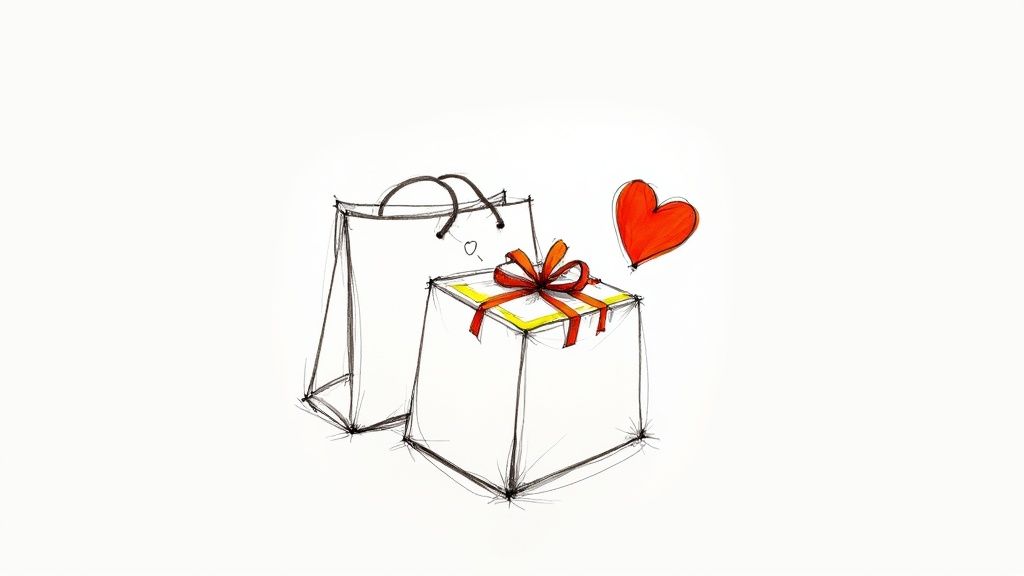
Imagine: lunchtime. Stomach rumbling. You pull out your phone to order food. Two apps offer the same delicious meal. One takes two taps to order. The other? Ten clicks, multiple screens, and a password you can’t remember. Which do you choose? Exactly. Your customers think the same way.
In the world of online shopping, speed is king. For the ecommerce customer journey, speed isn't just a nice perk—it's a fundamental expectation. This section explores why customers abandon their carts, why they bounce off websites, and why they might choose a competitor over you.
The Problem of Friction
The number one reason for online shopping abandonment? Friction. Think of it like sandpaper on an otherwise smooth shopping experience. Friction is anything that slows customers down or makes them work too hard. A slow-loading website, a complicated checkout, or unanswered emails all create friction.
A website that takes ages to load is like a restaurant with a long line and no host. A confusing checkout process? Imagine trying to pay for groceries with a broken scanner and a cashier who’s new on the job. Slow email replies are like calling customer service and getting stuck on hold indefinitely. These all add up to a frustrating experience.
Hidden Costs of Slowness
Slowness can cost you real money. Every second a customer waits for your website to load is another second they might decide to leave, taking their potential purchase with them. A clunky checkout page can lead to abandoned carts and lost sales. And unanswered emails can leave customers feeling ignored and less likely to return.
Creating a smooth ecommerce customer journey means prioritizing customer needs. People want quick service. In fact, a whopping 72% of customers expect help immediately. Find out more about customer experience. They expect mobile-friendly websites, instant chat options, and speedy shipping. For many online shoppers, fast delivery is a deciding factor. More than half prioritize quick shipping when choosing where to shop.
Removing Friction
So, how do you create a frictionless experience? Think about streamlining every step of the customer journey. Here are a few key areas to focus on:
- Fast Website: A quick-loading website is crucial. No one wants to wait around for pages to load.
- Easy Checkout: Simplify your checkout process. The fewer steps, the better.
- Quick Replies: Respond to emails and messages promptly. Show your customers you value their time and business.
- Clear Information: Make product information easily accessible and understand. Don’t make customers hunt for details.
Speed Improvements for Big Results
Which changes will have the biggest impact? Prioritize these areas for improvement:
- Page Load Speed: A fast website is the foundation of a good online experience.
- Mobile-Friendly Design: Most online shopping happens on mobile devices. Ensure your site looks great and functions perfectly on all screens.
- One-Click Checkout: Offer one-click checkout for returning customers. This simplifies the process and encourages repeat purchases.
- Live Chat Support: Providing live chat support offers immediate assistance and answers questions in real-time.
By implementing these changes, you can remove friction, turn website visitors into loyal customers, and create a positive ecommerce customer journey that encourages repeat business.
Email That Follows Customers Step by Step
Email marketing isn't about sending the same generic email blast to everyone on your list. It's about building a relationship, understanding your customer, and offering the right information at just the right moment. Think of it like guiding a friend through a new city. You wouldn't give the same directions to someone just arriving at the airport as you would to someone already downtown.
Welcome Emails for New Visitors
Just like making a good first impression, your welcome email sets the tone for your entire relationship with a new subscriber. Whether they signed up for your newsletter or made their first purchase, this email is crucial. It's your chance to say hello and offer some value right off the bat.
- Thank them for joining your community. Make them feel like they belong.
- Offer helpful tips related to their purchase or interests. Provide practical advice.
- Consider a small discount on their next order. Sweeten the deal.
For example, if someone buys a new camera, your welcome email could offer photography tips or suggest useful accessories. This shows you're invested in their success and builds a connection beyond the initial sale.
Cart Abandonment Emails for Lost Sales
We've all been there: adding items to our online shopping cart and then getting distracted. This is called cart abandonment. A friendly reminder email can work wonders in recovering these lost sales.
- Include a picture of the abandoned item. Jog their memory.
- Offer a small discount to encourage the purchase. Provide a little nudge.
- Include a customer testimonial about the product. Build trust and confidence.
These emails should feel helpful, not pushy. They offer a gentle reminder and a little extra incentive to complete the purchase.
Thank You Emails for Recent Buyers
After a customer makes a purchase, a thank you email is a great opportunity to express your gratitude and further strengthen the relationship. It's also a chance to provide additional value and encourage future purchases.
- Include information about caring for their new purchase. Be helpful and informative.
- Suggest related products they might like. Offer personalized recommendations.
- Invite them to join your loyalty program. Reward their loyalty.
This reinforces their positive experience and makes them more likely to return.
Exclusive Offers for Loyal Customers
Your best customers, the ones who buy regularly, deserve special treatment. Exclusive offers and early access to new products make them feel valued and appreciated.
- Give them early access to sales and new products. Make them feel like VIPs.
- Offer birthday discounts. Add a personal touch.
- Invite them to special events. Build a sense of community.
These perks reinforce their loyalty and keep them engaged with your brand. Check out our guide on effective email flows for ecommerce for more strategies.
Automating Your Email Marketing
To streamline your efforts and deliver personalized messages at scale, you can use automated email sequences. These sequences trigger specific emails based on customer actions, creating a seamless and helpful experience throughout the entire ecommerce customer journey.
Instead of feeling like impersonal spam, your emails become timely and relevant messages delivered at just the right moment. Let’s take a look at how this could play out in a simple table:
To help illustrate this, here’s a table summarizing email types matched to the customer journey:
Email Types by Customer Journey Stage Strategic email campaigns matched to specific stages of the customer journey
| Journey Stage | Email Type | Purpose | Key Metrics |
|---|---|---|---|
| New Visitor | Welcome Email | Introduce your brand and offer value | Open Rate, Click-Through Rate |
| Cart Abandonment | Cart Reminder Email | Recover lost sales | Conversion Rate, Recovery Rate |
| Recent Buyer | Thank You Email | Express gratitude and build relationships | Open Rate, Click-Through Rate |
| Loyal Customer | Exclusive Offer Email | Reward loyalty and encourage repeat purchases | Conversion Rate, Repeat Purchase Rate |
This table provides a snapshot of how different email types can be strategically deployed at each stage of the customer journey. By tracking key metrics like open rates, click-through rates, and conversion rates, you can fine-tune your email campaigns for maximum effectiveness. Remember, email marketing is all about building relationships and offering value at every touchpoint.
Social Media for Each Step of the Journey
Social media isn't just about posting pretty pictures. Think of it as a powerful toolkit for guiding customers through their buying journey. Each platform offers unique ways to connect and nudge them closer to a purchase. Just like you wouldn't use a hammer for everything, each social media platform has its own special purpose.
Awareness: Introducing Your Brand
The first step is getting noticed. Platforms like Instagram and TikTok are excellent for building brand awareness. Imagine eye-catching visuals, short, engaging videos, and teaming up with influencers. Showcasing your products in action and highlighting their benefits in a relatable way is key. The goal is to make people aware of your brand and what you offer.
For example, imagine a clothing brand partnering with a fashion influencer on TikTok. Short, stylish videos of the influencer wearing the clothes can quickly grab attention and spark interest.
Consideration: Building Trust and Interest
Once people know you exist, it's time to build trust. Facebook groups are a great way to do this. Create a community around your brand where customers can ask questions, share experiences, and see real reviews from others.
Think about using Instagram Stories with Q&As and polls to gather customer feedback and understand their needs. This shows you're engaged and listening.
Decision: Helping Customers Choose
The decision stage is where customers weigh their options. Pinterest is perfect for this. Users can save and organize products they like, creating virtual wish lists and mood boards. This allows easy comparison of features, prices, and styles.
High-quality images and videos are crucial on Pinterest. Make sure your products look great and are easy for customers to picture in their own lives.
Action: Making it Easy to Buy
Once a customer decides to buy, make the process seamless. Social media platforms are incorporating more shopping features, letting customers buy directly through their feeds. Clear calls to action, like "Shop Now" buttons, are essential for driving conversions.
For example, Instagram Shopping allows businesses to tag products in their posts, creating a direct path from discovery to purchase.
Loyalty: Nurturing Relationships
Loyalty is about creating lasting relationships. Exclusive offers, behind-the-scenes content, and personalized interactions on social media can strengthen those connections.
Imagine a skincare brand offering exclusive discounts to their Instagram followers or hosting live Q&A sessions with their founder. This fosters a sense of community and makes customers feel valued. Check out our guide on building social proof for your ecommerce brand for additional strategies.
Choosing the Right Platforms
Not every platform works for every business. The best one for you depends on your target audience and goals. LinkedIn, for instance, is great for B2B companies building trust and showing their expertise.
Measuring Your Success
Tracking key metrics like engagement, reach, and conversions helps you understand what's working and what isn't. Use these insights to refine your strategy and improve your results.
By understanding the ecommerce customer journey and strategically using social media, you can guide customers from first contact to loyal fans, boosting sales and building relationships that last.
Your Action Plan That Actually Works
Knowing what to do is important, but actually doing it is what brings home the bacon. This section gives you a clear plan to improve your ecommerce customer journey, starting now. We'll focus on the changes that deliver the biggest bang for your buck and are the simplest to implement. You'll get a handy checklist to gauge customer sentiment and discover quick ways to boost sales this month. We'll also cover larger-scale changes, realistic timelines, and how to get your team on board.
Quick Wins for Immediate Impact
Think of these as small fixes, like patching a leaky faucet. Quick and easy changes can yield fast results:
Speed Up Your Website: A slow website is a customer repellent. Nobody wants to wait around for pages to load. Tools like Google's PageSpeed Insights can pinpoint issues and help you boost your site’s speed. A faster website equals happier customers.
Simplify Your Checkout: Make buying from you a breeze. Eliminate unnecessary steps and provide various payment options. A streamlined checkout means more sales.
Send Helpful Welcome Emails: Roll out the welcome mat! When someone signs up, send a friendly email with helpful tips and perhaps a small discount. This builds trust and encourages a first purchase.
These small tweaks can make a surprising difference to your sales this month. Small changes, big impact.
Bigger Projects for Long-Term Growth
These are more like building a new house than fixing a faucet. Bigger changes deliver long-term value:
Create a Loyalty Program: Reward your best customers with exclusive deals and sneak peeks at new products. This fosters lasting relationships and encourages repeat business.
Personalize Your Emails: Send emails tailored to what customers have previously bought or viewed. Personalized emails feel much more special than generic blasts.
Build a Strong Social Media Plan: Use different platforms for different purposes. Share engaging videos on TikTok and cultivate a community on Facebook. A strategic social media plan expands your reach.
These larger projects require more time and effort, but the payoff is worth it. Think long term.
Measuring Your Success
How do you know if your changes are working? Keep a close eye on these vital metrics:
Conversion Rate: Out of all your website visitors, how many actually make a purchase?
Cart Abandonment Rate: How many people add items to their cart but don't complete the checkout process?
Customer Lifetime Value: How much money does the average customer spend with you over their entire relationship with your brand?
These numbers tell a story. They reveal what's working and what's not. Use this data to refine your ecommerce customer journey and continually improve your business.
Getting Your Team On Board
If you're working with a team, it's crucial to get them excited about the changes. Clearly explain why these changes are important and how they will benefit everyone. A motivated team is a powerful team.
Whether you're a solo entrepreneur or leading a team, focusing on the ecommerce customer journey is the key to sustained success. It's like building a solid foundation for a house – it takes time and effort, but it’s essential for stability and growth.
